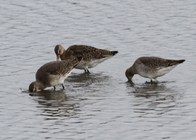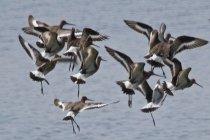
| Introduction | | Search taxa | | Taxon tree | | Taxon match | | Checklist | | Literature | | Stats | | Photogallery | | OBIS Vocab | | Log in |
CaRMS taxon detailsLimosa limosa (Linnaeus, 1758)
159035 (urn:lsid:marinespecies.org:taxname:159035)
accepted
Species
Not documented
Description Length: male 40-41 cm, female 50 cm. Plumage: above plain grey-brown; below whitish; head, neck and breast light brownish;...
Description Length: male 40-41 cm, female 50 cm. Plumage: above plain grey-brown; below whitish; head, neck and breast light brownish; pale superciliary line; white bar with black trailing edge in spread wing; rump white, tail band black; breeding bird mottled brownish above, head and chest reddish chestnut, flanks barred black, belly whitish. Bare parts: iris hazel to dark brown; bill long and straight, blackish with basal third or more orange-pink to pinkish; feet and legs greyish- or bluish-grey to blackish. Habitat: tidal mudflats and inland waters. Palearctic migrant. <389><391><393> [details] Distribution accidental shore bird from Eurasia, reported in Newfoundland
Distribution accidental shore bird from Eurasia, reported in Newfoundland [details]
CaRMS (2021). Limosa limosa (Linnaeus, 1758). Accessed at: http://marinespecies.org/carms./aphia.php?p=taxdetails&id=159035 on 2024-04-19
Nozères, C., Kennedy, M.K. (Eds.) (2024). Canadian Register of Marine Species. Limosa limosa (Linnaeus, 1758). Accessed at: https://www.marinespecies.org/CaRMS/aphia.php?p=taxdetails&id=159035 on 2024-04-19
context source (Schelde)
Maris, T.; Beauchard, O.; Van Damme, S.; Van den Bergh, E.; Wijnhoven, S.; Meire, P. (2013). Referentiematrices en Ecotoopoppervlaktes Annex bij de Evaluatiemethodiek Schelde-estuarium Studie naar “Ecotoopoppervlaktes en intactness index”. <em>Monitor Taskforce Publication Series, 2013-01. NIOZ: Yerseke.</em> 35 pp. (look up in IMIS) [details]
basis of record Integrated Taxonomic Information System (ITIS). , available online at http://www.itis.gov [details] additional source Peterson, R.T.; Peterson, V.M. (2002). A field guide to the birds of eastern and central North America. <em>Fifth Edition.</em> Peterson Field Guide Series. Houghton Mifflin Company. New York. 427 p. [details] additional source Urban, E. K.; Fry, C. H.; Keith, S. (1986). The Birds of Africa, Volume II. <em>Academic Press, London.</em> [details] additional source Muller, Y. (2004). Faune et flore du littoral du Nord, du Pas-de-Calais et de la Belgique: inventaire. [Coastal fauna and flora of the Nord, Pas-de-Calais and Belgium: inventory]. <em>Commission Régionale de Biologie Région Nord Pas-de-Calais: France.</em> 307 pp., available online at http://www.vliz.be/imisdocs/publications/145561.pdf [details] additional source King, C.M.; Roberts, C.D.; Bell, B.D.; Fordyce, R.E.; Nicoll, R.S.; Worthy, T.H.; Paulin, C.D.; Hitchmough, R.A.; Keyes, I.W.; Baker, A.N.; Stewart, A.L.; Hiller, N.; McDowall, R.M.; Holdaway, R.N.; McPhee, R.P.; Schwarzhans, W.W.; Tennyson, A.J.D.; Rust, S.; Macadie, I. (2009). Phylum Chordata: lancelets, fishes, amphibians, reptiles, birds, mammals. <em>in: Gordon, D.P. (Ed.) (2009). New Zealand inventory of biodiversity: 1. Kingdom Animalia: Radiata, Lophotrochozoa, Deuterostomia.</em> pp. 431-554. [details] additional source Gallardo, J. C.; Macías, V.; Velarde, E. (2009). Birds (Vertebrata: Aves) of the Gulf of Mexico. <em>In: Felder, D.L. and D.K. Camp (eds.), Gulf of Mexico–Origins, Waters, and Biota. Biodiversity. Texas A&M Press, College Station, Texas.</em> Pp. 1321–1342. [details] additional source Liu, J.Y. [Ruiyu] (ed.). (2008). Checklist of marine biota of China seas. <em>China Science Press.</em> 1267 pp. (look up in IMIS) [details] Available for editors  Present Present  Inaccurate Inaccurate  Introduced: alien Introduced: alien  Containing type locality Containing type locality
From other sources
Description Length: male 40-41 cm, female 50 cm. Plumage: above plain grey-brown; below whitish; head, neck and breast light brownish; pale superciliary line; white bar with black trailing edge in spread wing; rump white, tail band black; breeding bird mottled brownish above, head and chest reddish chestnut, flanks barred black, belly whitish. Bare parts: iris hazel to dark brown; bill long and straight, blackish with basal third or more orange-pink to pinkish; feet and legs greyish- or bluish-grey to blackish. Habitat: tidal mudflats and inland waters. Palearctic migrant. <389><391><393> [details]Distribution accidental shore bird from Eurasia, reported in Newfoundland [details]
|

